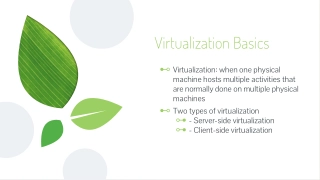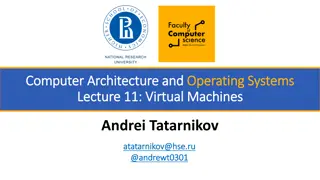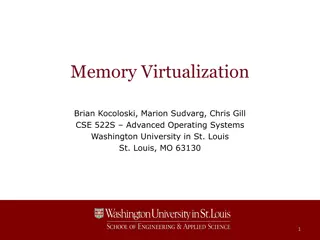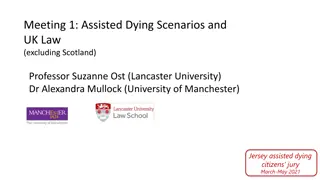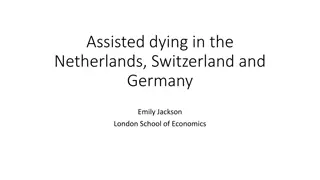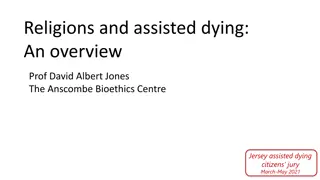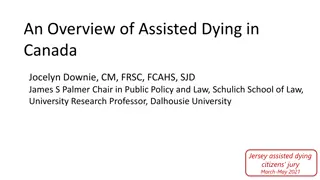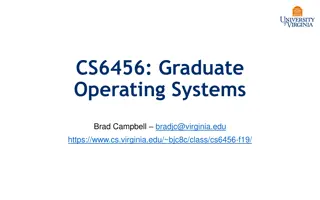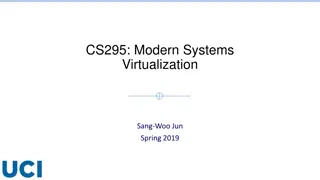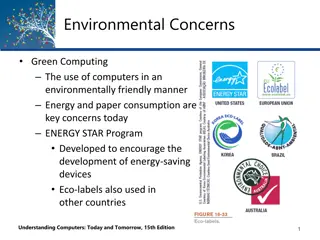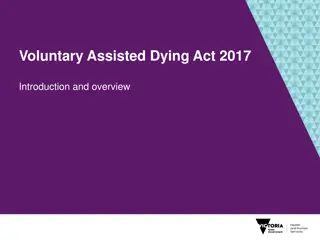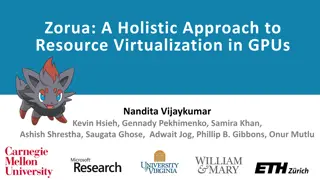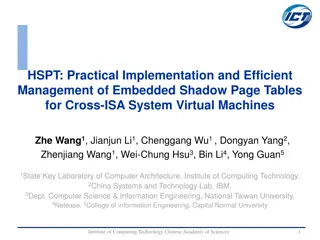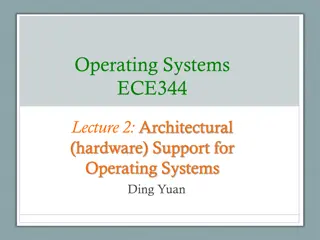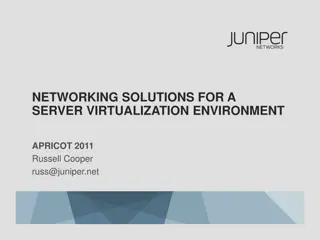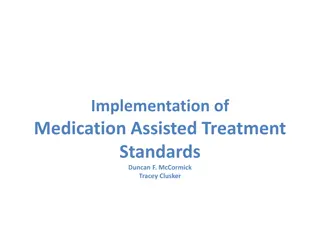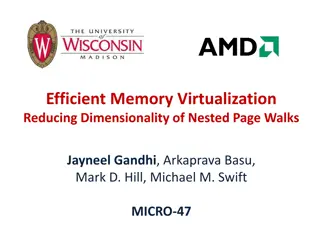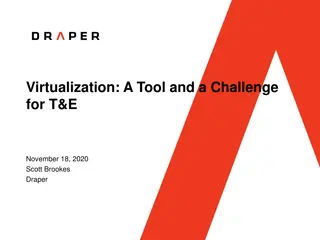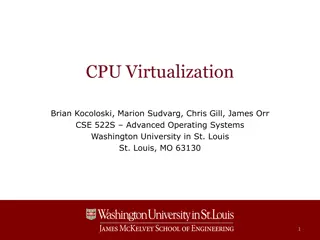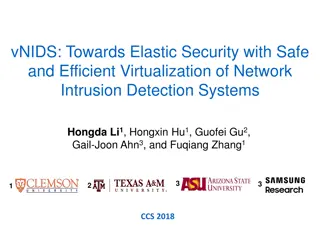Hardware-Assisted Virtualization: VT-x Overview and Implementation
Explore the key concepts of hardware-assisted virtualization using Intel VT-x technology for CPU virtualization, VMX transitions, and VM control structures. Understand the motivation behind VT-x, CPU virtualization techniques, and the benefits of VT-x in simplifying VMM software. Dive into VMX operations, transitions, de-privileging of guest OS, and more. Enhance your knowledge of VT-x for efficient virtualization in operating systems.
Download Presentation

Please find below an Image/Link to download the presentation.
The content on the website is provided AS IS for your information and personal use only. It may not be sold, licensed, or shared on other websites without obtaining consent from the author. Download presentation by click this link. If you encounter any issues during the download, it is possible that the publisher has removed the file from their server.
E N D
Presentation Transcript
Hardware-assisted Virtualization 15-612 Operating System Practicum Carnegie Mellon University Pratik Shah (pcshah) Rohan Patil (rspatil) 1
Agenda Introduction to VT-x CPU virtualization with VT-x VMX VMX Transitions Virtual Machine Control Structure (VMCS) MMU Virtualization with VT-x Virtual Processor IDentifier (VPID) Sidebar: Virtualizing memory in software Nested / Extended Page Tables (EPT) References Q & A 2
VT-x Intel Vanderpool Technology, referred to as VT-x, represents Intel s virtualization technology on the x86 platform. 3
VT-x : Motivation To solve the problem that the x86 instructions architecture cannot be virtualized. Simplify VMM software by closing virtualization holes by design. Ring Compression Non-trapping instructions Excessive trapping Eliminate need for software virtualization (i.e paravirtualization, binary translation). 4
VMX Virtual Machine Extensions define processor-level support for virtual machines on the x86 platform by a new form of operation called VMX operation. Kinds of VMX operation: root: VMM runs in VMX root operation non-root: Guest runs in VMX non-root operation Eliminate de-privileging of Ring for guest OS. 6
Pre VT-x Post VT-x VMM ring de-privileging of guest OS VMM executes in VMX root-mode Guest OS aware its not at Ring 0 Guest OS de-privileging eliminated Guest OS runs directly on hardware 7 Source: [2]
VMX Transitions Transitions between VMX root operation and VMX non- root operation. Kinds of VMX transitions: VM Entry: Transitions into VMX non-root operation. VM Exit: Transitions from VMX non-root operation to VMX root operation. Registers and address space swapped in one atomic operation. 8
VM 1 VM 2 VM n VMX Non-Root Operation Ring 3 Ring 3 Ring 3 Ring 0 Ring 0 Ring 0 VM Entry VMCS 1 VMCS 2 VMCS n VM Exit Ring 3 VMX Root Operation vmlaunch / vmresume Ring 0 VMX Transitions 9
VMCS: VM Control Structure Data structure to manage VMX non-root operation and VMX transitions. Specifies guest OS state. Configured by VMM. Controls when VM exits occur. 10
VMCS: VM Control Structure The VMCS consists of six logical groups: Guest-state area: Processor state saved into the guest- state area on VM exits and loaded on VM entries. Host-state area: Processor state loaded from the host- state area on VM exits. VM-execution control fields: Fields controlling processor operation in VMX non-root operation. VM-exit control fields: Fields that control VM exits. VM-entry control fields: Fields that control VM entries. VM-exit information fields: Read-only fields to receive information on VM exits describing the cause and the nature of the VM exit. 11
CPU Virtualization with VT-x 12 Source: [2]
VPID: Motivation First generation VT-x forces TLB flush on each VMX transition. Performance loss on all VM exits. Performance loss on most VM entries Guest page tables not modified always Better VMM software control of TLB flushes is beneficial. 14
VPID: Virtual Processor Identifier 16-bit virtual-processor-ID field in the VMCS. Cached linear translations tagged with VPID value. No flush of TLBs on VM entry or VM exit if VPID active. TLB entries of different virtual machines can all co-exist in the TLB. 15
Virtualizing Memory in Software Three abstractions of memory: 0 4GB Virtual Current Guest Process Guest OS Address Spaces 0 4GB Physical Address Spaces Virtual Frame Buffer Virtual Devices Virtual ROM Virtual RAM 0 4GB Machine Address Space Frame Buffer RAM Devices ROM 16 Source: [6]
Shadow Page Tables VMM maintains shadow page tables that map guest-virtual pages directly to machine pages. Guest modifications to V->P tables synced to VMM V->M shadow page tables. Guest OS page tables marked as read-only. Modifications of page tables by guest OS -> trapped to VMM. Shadow page tables synced to the guest OS tables 17
Guest Page Table Guest Page Table Guest Page Table Virtual CR3 Real CR3 Shadow Page Table Shadow Page Table Shadow Page Table Set CR3 by guest OS (1) 18 Source: [6]
Guest Page Table Guest Page Table Guest Page Table Virtual CR3 Real CR3 Shadow Page Table Shadow Page Table Shadow Page Table Set CR3 by guest OS (2) 19 Source: [6]
Drawbacks: Shadow Page Tables Maintaining consistency between guest page tables and shadow page tables leads to an overhead: VMM traps Loss of performance due to TLB flush on every world- switch . Memory overhead due to shadow copying of guest page tables. 20
Nested / Extended Page Tables Extended page-table mechanism (EPT) used to support the virtualization of physical memory. Translates the guest-physical addresses used in VMX non-root operation. Guest-physical addresses are translated by traversing a set of EPT paging structures to produce physical addresses that are used to access memory. 21
Nested / Extended Page Tables 22 Source: [2]
Nested / Extended Page Tables 23 Source: [4]
Advantages: EPT Simplified VMM design. Guest page table modifications need not be trapped, hence VM exits reduced. Reduced memory footprint compared to shadow page table algorithms. 24
Disadvantages: EPT TLB miss is very costly since guest-physical address to machine address needs an extra EPT walk for each stage of guest-virtual address translation. 25
References 1. Intel 64 and IA-32 Architectures Software Developer s Manual (Volume 3C, Part 3) http://download.intel.com/products/processor/manual/326019.p df Intel Virtualization Technology Processor Virtualization Extensions and Intel Trusted execution Technology repo.meh.or.id/Todo/virtualization.pdf Intel Virtualization Technology Primer by Rich Uhlig software.intel.com/file/26677 Hardware Virtualization blogs by Johan De Gelas at AnandTech http://www.anandtech.com/show/2480/9 http://www.anandtech.com/show/2480/10 Performance Evaluation of Intel EPT Hardware Assist http://www.vmware.com/pdf/Perf_ESX_Intel-EPT-eval.pdf Memory Virtualization by Scott Devine, VMware Labs labs.vmware.com/download/46/ 2. 3. 4. 5. 26 6.
Questions 27
Thank You 28


